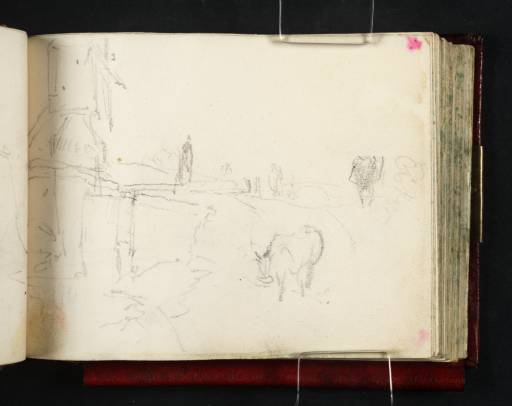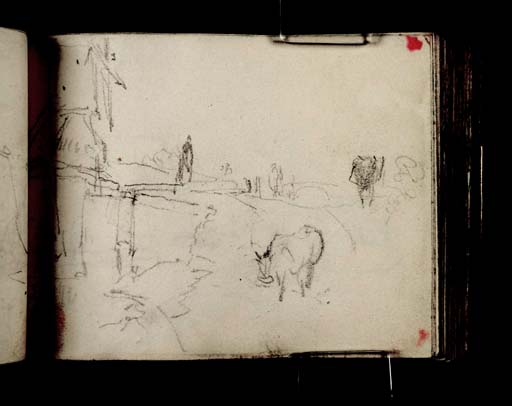Joseph Mallord William Turner A Windmill, a Lock and a Bridge, Probably on the Grand Junction Canal at Hanwell c.1808
Image 1 of 2
Joseph Mallord William Turner,
A Windmill, a Lock and a Bridge, Probably on the Grand Junction Canal at Hanwell
c.1808
Joseph Mallord William Turner 1775–1851
Folio 72 Verso:
A Windmill, a Lock and a Bridge, Probably on the Grand Junction Canal at Hanwell circa 1808
D08055
Turner Bequest CXIV 72a
Turner Bequest CXIV 72a
Pencil on white wove paper, 87 x 117 mm
Accepted by the nation as part of the Turner Bequest 1856
References
1909
A.J. Finberg, A Complete Inventory of the Drawings of the Turner Bequest, London 1909, vol.I, p.313, CXIV 72a, as ‘Windmill and lock. Said to be the Grand Junction Canal near Hanwell’.
1910
Alexander J. Finberg, Turner’s Sketches and Drawings, London 1910, pp.61, 94, pl.XXVII (a), as ‘Mill on the Grand Junction Canal, near Hanwell’, circa 1809.
1951
Hilda F. Finberg, ‘Turner’s Gallery in 1810’, The Burlington Magazine, vol.93, December 1951, p.384 under no.2.
1967
Evelyn Joll, Agnew’s 150th Anniversary: Loan Exhibition of Paintings and Watercolours by J.M.W. Turner, R.A., exhibition catalogue, Thomas Agnew & Sons, London 1967, p.23 under no.11.
1974
Gerald Wilkinson, The Sketches of Turner, R.A. 1802–20: Genius of the Romantic, London 1974, reproduced p.105.
1977
Evelyn Joll, Turner: A Special Loan Exhibition of 20 Rarely Seen Paintings, exhibition catalogue, Tate Gallery, London 1977, p.[20] under no.11.
1984
Martin Butlin and Evelyn Joll, The Paintings of J.M.W. Turner, revised ed., New Haven and London 1984, p.72 under no.101.
1996
Gillian Forrester, Turner’s ‘Drawing Book’: The Liber Studiorum, exhibition catalogue, Tate Gallery, London 1996, pp.77 under no.27, 78 note 2.
2001
Andrew Loukes and Andrew Kennedy, ‘Canals’ in Evelyn Joll, Martin Butlin and Luke Herrmann (eds.), The Oxford Companion to J.M.W. Turner, Oxford 2001, p.40.
As Finberg and others have recognised and discussed,1 this view of a canal-side windmill, said to be at Hanwell, is the basis of Turner’s painting Grand Junction Canal at Southall Mill, exhibited at his gallery in 1810 (currently untraced);2 there is a slight continuation of the canal bank to the left on folio 73 recto (D08056), and a view from further away in the same direction on folios 71 verso–72 recto (D08053, D08054).
Turner’s early biographer Thornbury reported that Turner recorded the scene one night, returning from visiting his friend the Rev. H.S. Trimmer at Heston,3 about ten miles from central London, and not far west of Isleworth, where Turner had lived by the Thames in 1805. W.G. Rawlinson was informed that the mill had been near the site of a later asylum in Hanwell,4 the site of which is now occupied by St Bernard’s Wing, Ealing Hospital, between the Uxbridge Road to the north and the Grand Union Canal and Osterley Park to the south. There are several locks along this stretch, and Windmill Lane crosses the canal at Windmill Bridge a little to the west. The Grand Junction Canal (later part of the Grand Union Canal) was begun in 1793 as a link from London to existing canals passing through the Midlands, and the Paddington Arm and basin had opened in 1801.5
The subject of a silhouetted windmill may have been partly influenced by the painting The Mill by (or after) Rembrandt van Rijn (1606–1669), exhibited at the British Institution in London as recently as 1806, to which Turner referred in his notes and lectures6 (National Gallery of Art, Washington). Finberg used this drawing as an example of ‘sketches that are nothing more nor less than memoranda for the artist’s own use’,7 apparently ‘scarcely intelligible’ yet indicative of ‘the state of mind in which a passionately felt work of art comes to birth’.8
For Turner’s 1811 Liber Studiorum engraving of the subject, see the entry for Tate N02941. The composition is recorded, as ‘6[:] 1 Windmill & Junction’, in the Liber Notes (2) sketchbook (Tate D12157; Turner Bequest CLIV (a) 24), in a draft schedule of the first ten parts of the Liber (D12156–D12158; CLIV (a) 23a–24a)9 dated by Finberg and Gillian Forrester to before the middle of 1808,10 which would suggest that the painting or Turner’s conception of the subject must date from some two years before its first exhibition.
As set out in the Introduction, there are various landscape studies in this sketchbook, occupying several pages from folios 28 recto to 38 recto (D07999–D08010), and from folios 70 recto to 73 recto (D08051–D08056). The last of the earlier sketches show the River Brent, north-west of London, which merges with the Grand Union Canal at Hanwell.
Matthew Imms
January 2012
See Finberg 1909, I, p.313; Finberg 1910, pp.61, 94; Finberg 1951, p.384; Joll 1967, p.23; Joll 1977, p.[20]; Butlin and Joll 1984, p.72; Forrester 1996, pp.77 under no.27, 78 note 2; and Loukes and Kennedy 2001, p.40.
Butlin and Joll 1984, pp.72–3 no.101, pl.108 (colour); Martin Butlin, ‘Lost, stolen and destroyed works’ in Joll, Butlin and Herrmann 2001, p.178.
W[illiam] G[eorge] Rawlinson, Turner’s Liber Studiorum, A Description and a Catalogue, London 1878, p.61.
‘The Grand Junction Canal’, London Canal Museum, accessed 10 April 2006, http://www.canalmuseum.org.uk/history/grandjun.htm .
How to cite
Matthew Imms, ‘A Windmill, a Lock and a Bridge, Probably on the Grand Junction Canal at Hanwell c.1808 by Joseph Mallord William Turner’, catalogue entry, January 2012, in David Blayney Brown (ed.), J.M.W. Turner: Sketchbooks, Drawings and Watercolours, Tate Research Publication, December 2012, https://www


